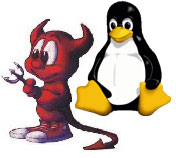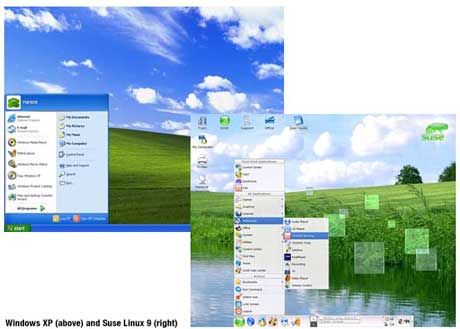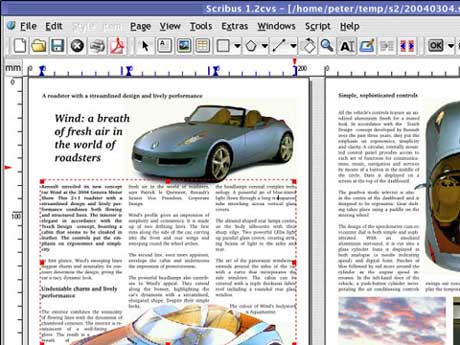Consulting, convening, coding, covering new ground, plus occasional commentary.
What not-for-profit organizations need to know about free software
Collaboratively authored by Dmytri Kleiner and Phillip Smith
Last updated December 2004
 Like many curious onlookers, you're probably wondering, Are free and open-source applications really able to meet our needs? or, Are open-source systems compatible with the software that our clients, partners and colleagues are using? The honest answer is yes. In the past two years, the pace of open-source desktop development has increased dramatically, the usability of Linux has been improved, and many brands you experience every day, like the Government of Canada, CNN, Google and Yahoo, use open-source software to power their Web sites.
Like many curious onlookers, you're probably wondering, Are free and open-source applications really able to meet our needs? or, Are open-source systems compatible with the software that our clients, partners and colleagues are using? The honest answer is yes. In the past two years, the pace of open-source desktop development has increased dramatically, the usability of Linux has been improved, and many brands you experience every day, like the Government of Canada, CNN, Google and Yahoo, use open-source software to power their Web sites.
If you have never heard the terms "free software" or "open source," don't worry, you're not alone. If you have heard about free software and have questions about how it could support your organization's work, keep on reading.
Free software as a global movement
It's the summer of 2004, and the free-software movement is reaching a critical mass. Schools, governments, community organizations and people and just like you are using free software. They're using it to save money, to ensure that staff and volunteers have access to the software they need, to get the most out of existing hardware and, more often, to be part of the global struggle to keep what is often referred to as "information and communication technologies" (ICTs) accessible to everyone.
From the simplest of information technology (IT) uses--like backups, security and desktop productivity--to the vanguard of information sharing--where organizations coalesce into "information ecosystems," sharing and distributing content amongst themselves--non-governmental organizations (NGOs) the world over are leveraging open-source software to engage their communities, facilitate collaboration and wage successful online campaigns for peace, justice and human security.
The time has come for more organizations to explore a movement that not only parallels the philosophical foundations of the not-for-profit sector but can empower these organizations to achieve more with less. Whether it's looking at how something as simple as a new operating system can help your organization increase productivity and information security while reducing overall costs, or finding new ways to link your community of interest together with Web-based tools and social-network software, open-source and free software are leading the way, and it's time you investigated how it can support your work.
But is it really free?
The first thing to know about free and (most) open-source software is that it's, well--free. However, "free" in this context means more than "at no cost." It also speaks to the concepts of liberty and freedom.
One of the most often used examples of free software is the GNU/Linux (usually referred to as just Linux) operating system. Some well-known examples of not-free software (often called proprietary or closed-source software) are the Microsoft Windows operating system and donor-management applications like Raiser's Edge, are often quite comparable to their commercial equivalents.

Free beer: when free actually means "at no cost"
The use of information and communication technologies is pervasive in most parts of the industrialized world. If you're reading this, chances are your organization has ICT infrastructure, like computers and software. That software is likely to include standard productivity applications like Microsoft Word, Excel, PowerPoint and Outlook; it also may include graphic or Web-design applications like Adobe's Photoshop or Macromedia's Dreamweaver. Even with not-for-profit pricing or donated-software availability, the cost of these applications can become expensive when multiplied by the number of different applications that an organization might require. For example, through TechSoup's software-donation program), a copy of the Microsoft Exchange server and ten client-access licences would cost approximately $100 (U.S.). Add to that cost the administrative time to apply to the program and to navigate the overly complex restrictions--such as being restricted to requesting software once every two years and then to only six titles per request--and even "donated" software quickly becomes a serious investment.
A standard installation of a Linux desktop operating system, however, comes with hundreds of software programs, including most of the applications that are required for basic office productivity: e-mail management, Web browsing, scheduler, task manager, address book, word processor, and spreadsheet and presentation creator. In addition, a new Linux user will find a broad range of applications installed by default, including a full-featured graphics image manipulation program (GIMP).

Many organizations also rely on network-based services, like file sharing, and having access to e-mail and the Web via a common local-area network and server. An organization with more technical requirements may also administer their own Web, e-mail, database and directory servers. Software for these services is often more expensive than desktop software--often thousands of dollars for applications like Microsoft Exchange, Active Directory, Internet Information and SQL server (TechSoup's administrative fee is also higher for these applications, often reaching hundreds of dollars for the application plus client access licences).
Similar to the applications that are provided with a standard desktop version of Linux, the free and open-source software options for running network services are even more robust and ubiquitous. For example, almost half of the Web sites on the Internet are served up by the open source Apache (a Microsoft Outlook-friendly Web-based, collaboration platform).
Like many organizations have discovered, it makes economic sense to run free software in at least some of these scenarios. However, as eluded to, free software means much more than "at no cost." Free software more often and more accurately speaks to the freedoms protected by the software licence and the liberty to use and modify the software for your needs.
The four freedoms
The "free" in free software most accurately refers to the licence that has been applied to it--often the GNU general public licence (GPL), a variation of that licence or one of the many other "free" or open-source software licenses. The objective of these public licences is to keep software free of the restrictions often placed on people's use of the software through proprietary and closed-source licences, such as ongoing licensing fees, adapting or improving the software, or installing the software on more than one computer at a time. For example, with most proprietary software you are not legally allowed to install the software on both your desktop and laptop computers, even though you many never use them simultaneously. The same goes for installing the same software on both your old Microsoft Windows system and the fancy new Apple G5 that you just wrangled out of your executive director--even though you paid dearly for the software just months ago.
Finally, whether you beg, borrow or steal your non-free software, you are often restricted from changing it, modifying it to suit your needs or benchmarking it against other options. In fact, the licences for most proprietary software tend toward restricting your use of the software and removing any responsibility on the part of the vendor in the case of software failure. For example, in a recent comparison of Microsoft's end user licence agreement (EULA) and the GNU GPL, the authors summarized the two as follows:
It is one of the more generally repeated presumptions of users who select to purchase and operate Microsoft's applications released under the EULA (over corresponding Open Source applications released under the GPL), that they do so because they have someone to hold legally responsible in case of application software failure or catastrophic error. A close reading of the EULA reveals that the licence explicitly removes all avenues and all recourse that a user of Microsoft's software has for legal relief of any sort. At best, you may recover the cost of the software product, or US$5. (You can read the full report here.)
In contrast, the philosophical underpinnings of the free-software movement are the "four freedoms," which exist to protect the right to run a program for any purpose, to study how the program works, and to adapt it as required. It also permits the redistribution of software, for free or for a fee, so that code can be shared and encourages developers to release improvements back to the community. The founder of the free-software movement, Richard Stallman, states one of his underlying beliefs as: "Above all, society needs to encourage the spirit of voluntary cooperation in its citizens."
For many, there is a powerful and important parralel between the free-software movement, global NGOs and the broader citizen sector. From their struggles against corporate globalization to their passion and philosophical beliefs--these two movements have more in common than recognizable at first glance. This comonality is becoming the focus of reseach and writing and gatherings and will drive simplier understandings, such as: "Free software is like organic food," or "Free software is like banking at a credit union." Another colourful anology that we came up with is: Free and open-source software is like vintage clothes: something you shop for on weekends, can be intensely personal, is easily modified, and generally improves with age. Somehow, great clothes continue to make it back into second-hand stores and give folks something to shop for on weekends. It's like a gift that keeps on giving.
No more serial numbers, no more CD keys
The not-for-profit community is often struggling for human resources just as much as any other. This often equates to ad-hoc project teams that consist of a mix of full- and part-time staff, temporary contract workers and volunteers. Computers in this scenario are often in flux between a number of uses and needs, which makes it difficult to keep track of software installation CDs, serial numbers, licences and just plain knowing what's installed where. Some organizations drift into a situation where they are not complying with the licences of the software they are using, in effect engaging in software piracy.
With free software you can always upgrade to the latest version and the the software will likely run on the hardware you're already using, often because someone, somewhere, has the same hardware and has made sure that the latest version runs on it. And if not, you can most likely find someone who will make it work with relative ease and for a reasonable cost.
So the question is: why engage in software piracy--even unknowingly--when you don't have to? Why install Microsoft Office on that new computer when OpenOffice is yours for the downloading? Why bother with the endless hassle of licences, serial numbers and CD keys, when you can liberate your organization by choosing free software? As the Free Software Foundation's David Turner said recently to a room of of activists and MIT students, "It's like stealing drugs from your dealer but not admitting that you're an addict."
Free software: adaptable and sustainable
A significant number of not-for-profit and community organizations hire consultants or programmers to develop specialized database tools, intranets, Web sites, administrative systems and other customized applications. In particular, these organizations have the most to benefit from exploring free software. Conversely, organizations that use not-free software--despite their investments in custom development and maintainence--are continuing down a path of dependency, often being required to pay for new licences to run their own applications when the underlying technology requires upgrading. Using free software makes this scenario less likely and puts control back in the hands of the organization.
Another benefit of the distributed nature of free software development--where programmers from the Czech Republic to South Africa to Brazil are working in a variety of different economic realities--is broad hardware support. This global development process also means that open-source and free software is broadly internationalized, making many desktop and application interfaces available in hundreds of languages from around the globe. One project of note is the African Translate.org.za project that has resulted in versions of OpenOffice in Zulu, Afrikaans and Nothern Sotho.
Likely the most important advantage of the open-source development model for not-for-profit organizations is the lack of vendor, consultant or volunteer "lock-in." Simply, this means projects built on a foundation of open-source or free software can--and likely will--survive the loss of key vendors or developers, as long as there are individuals or organizations that still use the software. Additionally, many of the free-software licences guarantee that improvements or customizations made to the software remain open and freely available, meaning that another developer, consultant or volunteer could pick up where the project was left off and continue to support an organization's needs.
Old hardware is good hardware. Old software is bad software
Under-funded and no-budget organizations frequently try to squeeze a long life out of computer hardware to make the best use of small budgets. This often means using older or donated computers from other organizations or from "reduce, re-use and recycle" environmental technology groups like ReBoot.
One of the challenges of outdated technology is that many non-free software vendors develop their software to run on the latest hardware platforms. Inherent in that problem is another: developers are often unable to fix bugs or glitches that effect older or less-common hardware, either because the proprietary licence expressly forbids it or because the underlying source code that make the application work is not open to investigation. The software vendors themselves often have limited resources to support older hardware and, if the market of licensed users isn't big enough, may discontinue support for older versions of their software altogether. A great example of this is Microsoft's decision to discontinue support for their Windows 98 operating system, which has been in use for less than five years in many organizations. So, frequently, when upgrading non-free software, organizations are forced to also upgrade their hardware, which can equate to buying entirely new desktop systems to replace computers that are still adequate for most tasks.
In this situation, an organization is often faced with the dilemma of paying for expensive hardware and software upgrades or continuing to use the old hardware with the older version of the software. While working on old hardware may pose no significant challenges, using old software can be a uniquely frustrating experience, especially when the vendor no longer supports it and neither you no anyone else has the right to fix it. As time passes, the documents created using old software become more-and-more outdated and, eventually, it becomes difficult to share documents with others. And if the original installation media has become damaged or the serial numbers lost, you may not be able to find replacements, making a re-install of the software difficult or impossible.
So what are you afraid of? Just try it
It's easy to get started with your exploration of Free/Libre and open-source software. A great place to start is by downloading Firefox. Finally, if you're embarking on an IT initiative that involves building or programming custom software, take the time to investigate the open-source options, and ask your potential vendors to do the same.
Challenge yourself to at least experiment with free software wherever and whenever possible in your organization and personal life. Invite your friends and colleagues to do the same. Together, you will build a support network, a knowledge base and a community that you can all count on. Free software: it's more than just cost savings, it's a way of life.
About
Hi, I'm Phillip Smith, a veteran digital publishing consultant, online advocacy specialist, and strategic convener. If you enjoyed reading this, find me on Twitter and I'll keep you updated.

Related
Want to launch a local news business? Apply now for the journalism entrepreneurship boot camp
I’m excited to announce that applications are now open again for the journalism entrepreneurship boot camp. And I’m even more excited to ...… Continue reading
From the future
Getting smaller? How so? To what end?